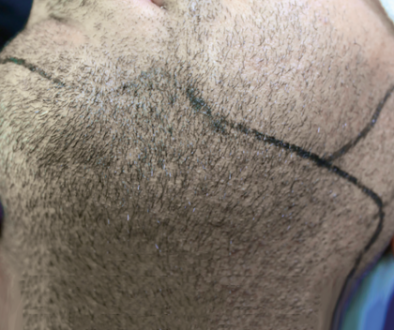Minimizing Native Hair Loss in and around the Hair Transplant Recipient Area
This comment, addressed by Coalition hair restoration surgeon Dr. Michael Beehner was shared by a member of our Hair Loss Social Community and Discussion Forums:
I have an uneven hairline due to genetic hair loss (androgenic alopecia) and was wondering the best way to save the native hairs when going through a follicular unit extraction hair transplant. Should I ask the hair restoration surgeon to work around the native hairs being careful not to plant too close or should he plant new hairs between the native (to go for density)?
I have seen lots of pictures where they planted right around the native hair and it seems the naturalness of the hairline was lost to the hair transplant and it became a thinner area in general.
I am very interested in achieving a natural looking result that would be potentially undetectable. Any suggestions from those who have experience?
 If you have early signs of classical patterned male pattern baldness, then many if not most of the hairs within the U-shaped area on top will be at some point of the spectrum of miniaturization. Our hairs typically live in 4-5 year long life cycles, are then shed, and then the follicle pushes out the next generation of hair. If it is in the area of MPB, then this next hair will be a little wispier, will grow to a shorter maximal length, and will have a shorter anagen (growth) cycle.
If you have early signs of classical patterned male pattern baldness, then many if not most of the hairs within the U-shaped area on top will be at some point of the spectrum of miniaturization. Our hairs typically live in 4-5 year long life cycles, are then shed, and then the follicle pushes out the next generation of hair. If it is in the area of MPB, then this next hair will be a little wispier, will grow to a shorter maximal length, and will have a shorter anagen (growth) cycle.
So, when you have a hair transplant procedure, the trauma of the surgery can “spook” some of the follicles in the area and send them into a 3-6 month hibernation with the hair falling out. The great majority of those hairs will re-emerge, but will have a little less “mass” to them and will be a little more “see-through.”
I would make four points that I think would help hang on to your native hair a little longer:
- Have your surgeon plant the follicular unit grafts at a lower than maximal density (probably 30/cm2 or less)
- Using the smallest possible sites helps (this task and the planting step are both best carried out with very high magnification, 4.5x or higher).
- The surgeon should use the minimal amount of epinephrine (Adrenaline) that is necessary to control bleeding. Most hair surgeons believe that too strong of a concentration of epi can promote shocking.
- A corollary of point #1 is that the task should be divided into two sessions instead of one. The cumulative “insult” to the follicles on top will be minimized.
One final point: It is my belief that a small amount of shocking to native hairs occurs with every hair transplant procedure and is only noticeable or complained about when the number of hairs affected is quite significant.
Mike Beehner, M.D.
—-
David (TakingThePlunge)
Editorial Assistant and Forum Co-Moderator for the Hair Transplant Network, the Coalition Hair Loss Learning Center, and the Hair Loss Q & A Blog.
To share ideas with other hair loss sufferers visit the hair loss forum and social community
Get Proven Treatments at the Best Prices by visiting our new online hair loss treatment shop.
Watch hair transplant videos on YouTube
Technorati Tags: hair loss, androgenic alopecia, follicular unit, hair transplant, male pattern baldness, MPB



